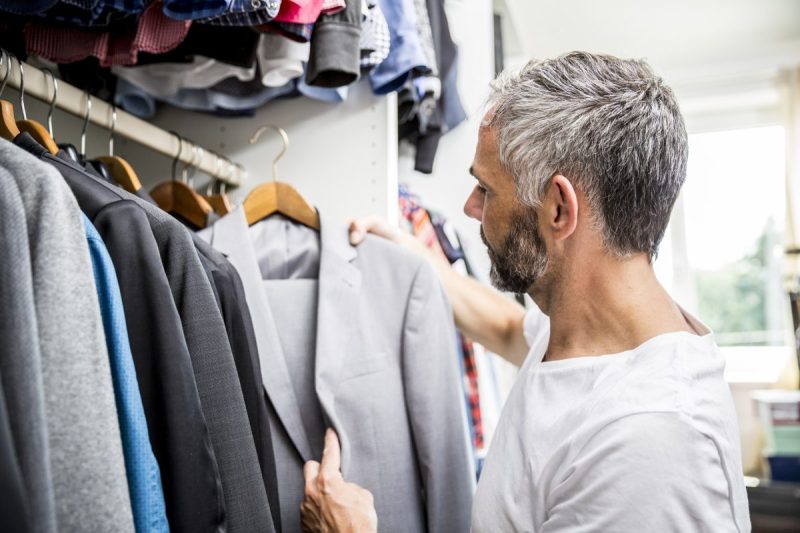
Like personal finance or basic kitchen skills, organizing your closet isn’t something that gets taught anymore. Now is the perfect time to refresh your drawers and cabinets for a fresh new season. If you’re like most guys, your parents (i.e., your mom) did this for you while you were growing up, sneaking into your bedroom while you were out to collect your sh** from off the floor and put it back into your closet and drawers where it belonged.
Focusing on something you can control — the clutter in your closet — is a rare treat. Organizing your closet is an undeniably good use of free time, and it will make it easier to find items you’re looking for.
We consulted an organizing expert, Jamie Hord, founder of Horderly, for her tips on how to reduce clutter and create an organizational system that will make your life a lot easier.
Note: If learning how to organize your closet seems scary and overwhelming, don’t feel like you need to do the whole thing all at once. The process might be cathartic for some, but for others, it might feel like it’s a major undertaking. It’s perfectly fine to choose just one section of your closet and work on that, then move on to the next.
Step 1: Before you start, consider the big picture

The first step Horderly recommends to get organized is to do a complete pull-out and sort of your closet and dressers. “Seeing all of your belongings pulled out and sorted into piles by category will make the next steps to organizing your closet so much easier,” Hordly said. “It will help you assess how much you have and how much you can let go of — or help you find a long-lost item!”
As tempting as it might be to go full Marie Kondo and purge your shelves of everything but the bare minimum, take a pause. While you might feel like you only need a few T-shirts and perhaps a shirt and tie; the day will come when you’ll want a multifunctional wardrobe.
Step 2: Edit your wardrobe

The easiest process that Horderly recommends while editing your belongings is to touch on each item individually and decide one of the following:
- Keep
- Toss
- Donate
Create piles by category (jeans, T-shirts, sweatpants, dress shirts, dress pants, and more) to help you see how much you really have. Work pile-by-pile and physically touch every item to determine whether it’s something you love and want to keep or if it would make someone else happy in the donation pile.
Horderly warns that you’ll be surprised how much you don’t use. “Try to only keep what you’re using often, or items that make you happy,” Horderly suggested. “Editing with a professional organizer or a decisive friend can make a huge difference — having someone there as a second eye or to ask you questions will help you make hard decisions.” If you have a pile of seven khakis and can’t even remember the last time you wore them, it’s time to downsize.
Also, don’t be afraid to try clothing on. We all have those jeans or shirts that we’re going to “fit back into,” but it’s not recommended to keep an entire wardrobe of those items. If it’s really special, keep it. Otherwise, when you get to that day when you “fit back into it,” you’re most likely going to be into a new style or want something new and fresh to treat yourself for your hard work.
Step 3: Assess what you have

Once you know which items you’re going to keep, it’s time to strategize placement in your closet. Whether you’re working with a professional organizer or you’re working on your own, you want to ask yourself questions about your inventory to get the most out of your organization.
Horderly suggests that the items you use most often should be given the most prime real estate in your closet. If you wear T-shirts and jeans every day, you want those front and center. If you wear hoodies all the time, make those the star of the closet. You can pretty much hang anything, except for sweaters, which can get damaged. So really think about what you wear the most often and put those items front and center.
After strategizing placement, it’s time to strategize products and take measurements to begin the final stages of the organizing process.
Step 4: Use the space that you have

While we’d all love a giant walk-in closet at our disposal, the truth is that most of us don’t need it. The best thing to do is to use and maximize the space that you already have. Horderly says your goal should be to clear the floor and counter space, so that your space is clutter-free. However, if you live in a smaller apartment and need to use some floor space, they recommend under-bed storage bins for off-season items or anything you’re not accessing often.
Many times people forget they can use the height of each space. “That could be maximizing wall space and putting a system of shelving in place, maximizing door height using a back-of-door system, or using stacking drawers to maximize a tall space under the sink or in low cabinets.”
Another forgotten area is the back of your door, which Horderly loves to use to maximize storage space. “Our favorite systems include The Container Store’s ELFA over-the-door rack,which can be completely customizable to create systems to hold shoes, hats, and other accessories on the back of the door. And if you have a lot of shoes, you can also get this over-the-door shoe bag that holds 12 pairs of shoes,” Hordly said.
Don’t be afraid to think outside the box, either. If you can’t find the right solution for your storage needs, get crafty. For example, you can use shower rings to hold ties and belts, repurpose a clothes hanger as a sunglasses rack, or use the tabs from beer cans to make tiered clothing hangers that maximize your closet space. You can even add a shower curtain rod in your closet to double its volume — these are the easiest handyman points you’ll ever score.
Step 5: Use a system that actually works for you

It’s natural to organize clothes by type: All your button-down shirts grouped together, followed by all your pants, etc. While that’s a fine start, it tends to fall apart quickly. (But you knew that already.)
Instead, try grouping your closet items by function. Hang up all your office clothes in one place together (button-downs, pants, blazers, etc.), then start a separate row for casual shirts, pants, and jackets. This will save you time when you’re getting dressed, and it will focus your attention on the options for each “category” of your routine so that you don’t end up wearing the same two or three familiar items every day.
Step 6: Store seasonal and occasional items

One of the most common causes of closet disorganization is trying to squeeze too much into a small space. While your stuff is in piles, do an inventory of what you’ll need for the next six months (late summer, spring, early fall) and put everything else into a “storage” pile.
Once you’re ready to tackle that pile, separate items that require gentle handling (fine sweaters, wool coats, cultural or ceremonial garments, etc.) and pack them away in vacuum-sealed bags. The rest can go into bins, crates, an old suitcase, and even garbage bags if that’s all you’ve got. Put these seasonal items into a garage, attic, or under your bed. Just make sure to label them!
Key items to help keep you organized

Hangers
Horderly suggests swapping all of your hangers out for matching, non-slip hangers. “Streamlining hangers not only makes your closet look better, but it makes it more functional, too.” Horderly always suggests that their clients use streamlined, slim hangers. “The slim design allows you to fit more on each hanging rod without feeling cramped,” they said.
Storage bins
If you don’t have too much drawer space, Horderly suggests placing bins on shelves to operate as makeshift drawers. These are great for folded activewear, seasonal accessories, or sweatshirts. Plus, these foldable drawers allow you to easily store them away if you don’t need the extra storage.
Shelf dividers
Shelf dividers are such useful sources that can help you keep your folded clothes organized and prevent them from toppling over. They are available in a variety of materials, including plastic, wood, and metal – choose them based on the aesthetics of your closet.
Under-bed storage
Horderly recommends keeping your floors and counter space clear, so that your space is clutter-free. However, if you live in a smaller apartment and need to use some floor space, use under-bed storage bins for off-season items or anything you’re not accessing often.
Hanging organizers
You can use hanging organizers to store a variety of your closet items, such as scarves, belts, and bags. They come in different sizes and with various numbers of compartments.
Hat organizers
If you’re a hat guy, you’ll want to see all of your different styles. Using the back of the door is a great way to see everything you own and maximize your storage space.
Shoe organizers
If you’re a sneakerhead or just someone with a lot of shoes, using the door is a great way to get shoes off the floor and organized. Add shoe racks that can neatly display your favorite kicks to avoid shoe piles on the bottom of your closet.
Editors' Recommendations
- Gloves up, here are some of the best boxing matches of all time
- What does CBD feel like? All your questions answered
- How to start journaling to support your own well-being
- Costco has a secret online store, Costco Next, that any member can access – here’s how


